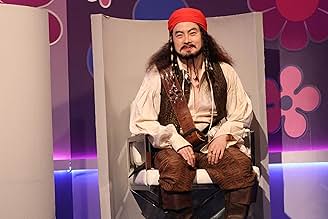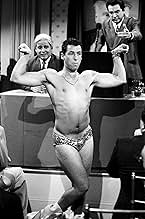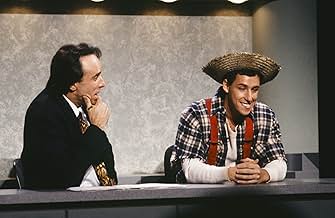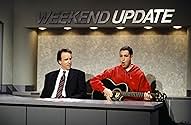Un invité célèbre met en scène des parodies et des sketches créés par la distribution de ce spectacle hilarant.Un invité célèbre met en scène des parodies et des sketches créés par la distribution de ce spectacle hilarant.Un invité célèbre met en scène des parodies et des sketches créés par la distribution de ce spectacle hilarant.
- Récompensé par 95 Primetime Emmys
- 234 victoires et 639 nominations au total
Parcourir les épisodes
Avis à la une
...also known as the SNL classic years,1975-1980, with the original cast. The reason is, since then, SNL has been running up and down like the stock market. Just when it looked like it was dead in 1980, Eddie Murphy emerges as an up and coming comic in his late teens. The rest is history. Murphy actually found that box office gold that Chevy Chase left SNL to find and never quite got. In 1992 SNL found some of its best political parody in years with the presidential candidacy of Ross Perot, a rich mine of comic material.
But let's go back to 1975 and talk about how it all started and was perceived. If you want to know where the U.S. was culturally and politically post-Watergate, you need look no further than season one of Saturday Night Live. You might say that the 60's didn't happen to America outside of special enclaves such as San Francisco until the 70's, and this show was part of that revolution.
In 1975, NBC was at the bottom of the then three-network barrel. Their only real hit show was Johnny Carson's "Tonight Show". So In 1974, when NBC Tonight Show host Johnny Carson requested that the weekend broadcasts of "Best of Carson" come to an end so that he could take 2 weeknights off and air repeats on those nights rather than on the weekend, NBC had no alternative but to comply with their star's wishes. To fill the gap, Lorne Michaels was hired to produce a new late-night show for the Saturday slot, and "Saturday Night Live" was born.
Michaels fought and cajoled network executives to accept his vision for the show, which was far removed from standard variety-show conventions. For example, one network executive, visiting a dress rehearsal, noticed that the band was in blue jeans and asked when their tuxedos would arrive. Before the show began Michaels had remarked that he knew what the "ingredients (of the show) would be, but not the proportions," and that the show would have to "find itself" on-air. Indeed, the Not Ready for Primetime Players were hardly featured in the premiere, but quickly became the focus of the show, with the guest host and musical act playing a secondary role. Albert Brooks and the Muppets were also dropped after the first season.
If you weren't old enough to follow politics or popular culture in 1975, you aren't going to get the jokes in their entirety. Fortunately, even if you are younger, you are in for quite a few musical treats as the musical guests are outstanding - Billy Preston performs "Nothing for Nothing"; Janis Ian performs "At Seventeen"; Paul Simon performed "Still Crazy After All These Years" and "Loves Me Like A Rock" solo and "The Boxer" and "Scarborough Fair" with Art Garfunkel; ABBA performed "Waterloo" and "S.O.S."; and The Stylistics performed "You Make Me Feel Brand New." These are all mainstream 70's songs and performers that should be recognizable to almost anyone. Musical guest appearances on TV may seem like no big deal in the age of instant digital musical gratification, but in 1975 such appearances were treasured.
However, if you are younger, you are going to miss out on some of the hard-biting political satire, including Chevy Chase's hilarious imitations of then President Ford featuring him constantly tripping over things, talking with the phone receiver inverted, and repeatedly telling a ceramic dog placed near his desk "Down Liberty, Down! Good Dog!" Also, the significance of certain guests such as President Ford's press secretary Ron Nessen will escape younger viewers - nobody under 50 who isn't a political science major is going to know who he is. Many elements of the regularly featured news skit "Weekend Update, which paved the way for shows such as "The Daily Show", will not be familiar to under-40 viewers such as the "Ferdinand Francisco Franco is still dead" remark that Chevy Chase keeps making. You'll find the original cast as "The South American Killer Bees" hilarious, but you probably won't know that at the time there actually was a scare that a particular poisonous and aggressive species of bee might migrate north from South America and start attacking Americans. I could go on and on, but you get the picture.
One of my favorite "characters", who makes his first appearance in a short skit in episode 15 of the first season, is "Mr. Bill". Mr. Bill is the clay figurine star of what at first appears to be a children's show. Each Mr. Bill episode would start innocently enough, but would quickly turn dangerous for Mr. Bill. Along with his dog, Spot, he would suffer various indignities inflicted by Mr. Hands, a man seen only as a pair of arms. Although often the abuse would ostensibly come from the mean Sluggo, another clay figure character. The violence would inevitably escalate, generally ending with Mr. Bill being crushed or dismembered while squealing, "Ohhhh noooooooooooooo...." It is like seeing the claymation duo of Davey and Goliath being run over and crushed by a tank, and is typical of the great "nothing is sacred" attitude this show had.
If you get a chance to pick up the first five seasons in particular, you will find yourself transported to another time of cynicism and great artistic freedom in which political correctness had not so constrained our ability to laugh at ourselves. Highly recommended.
But let's go back to 1975 and talk about how it all started and was perceived. If you want to know where the U.S. was culturally and politically post-Watergate, you need look no further than season one of Saturday Night Live. You might say that the 60's didn't happen to America outside of special enclaves such as San Francisco until the 70's, and this show was part of that revolution.
In 1975, NBC was at the bottom of the then three-network barrel. Their only real hit show was Johnny Carson's "Tonight Show". So In 1974, when NBC Tonight Show host Johnny Carson requested that the weekend broadcasts of "Best of Carson" come to an end so that he could take 2 weeknights off and air repeats on those nights rather than on the weekend, NBC had no alternative but to comply with their star's wishes. To fill the gap, Lorne Michaels was hired to produce a new late-night show for the Saturday slot, and "Saturday Night Live" was born.
Michaels fought and cajoled network executives to accept his vision for the show, which was far removed from standard variety-show conventions. For example, one network executive, visiting a dress rehearsal, noticed that the band was in blue jeans and asked when their tuxedos would arrive. Before the show began Michaels had remarked that he knew what the "ingredients (of the show) would be, but not the proportions," and that the show would have to "find itself" on-air. Indeed, the Not Ready for Primetime Players were hardly featured in the premiere, but quickly became the focus of the show, with the guest host and musical act playing a secondary role. Albert Brooks and the Muppets were also dropped after the first season.
If you weren't old enough to follow politics or popular culture in 1975, you aren't going to get the jokes in their entirety. Fortunately, even if you are younger, you are in for quite a few musical treats as the musical guests are outstanding - Billy Preston performs "Nothing for Nothing"; Janis Ian performs "At Seventeen"; Paul Simon performed "Still Crazy After All These Years" and "Loves Me Like A Rock" solo and "The Boxer" and "Scarborough Fair" with Art Garfunkel; ABBA performed "Waterloo" and "S.O.S."; and The Stylistics performed "You Make Me Feel Brand New." These are all mainstream 70's songs and performers that should be recognizable to almost anyone. Musical guest appearances on TV may seem like no big deal in the age of instant digital musical gratification, but in 1975 such appearances were treasured.
However, if you are younger, you are going to miss out on some of the hard-biting political satire, including Chevy Chase's hilarious imitations of then President Ford featuring him constantly tripping over things, talking with the phone receiver inverted, and repeatedly telling a ceramic dog placed near his desk "Down Liberty, Down! Good Dog!" Also, the significance of certain guests such as President Ford's press secretary Ron Nessen will escape younger viewers - nobody under 50 who isn't a political science major is going to know who he is. Many elements of the regularly featured news skit "Weekend Update, which paved the way for shows such as "The Daily Show", will not be familiar to under-40 viewers such as the "Ferdinand Francisco Franco is still dead" remark that Chevy Chase keeps making. You'll find the original cast as "The South American Killer Bees" hilarious, but you probably won't know that at the time there actually was a scare that a particular poisonous and aggressive species of bee might migrate north from South America and start attacking Americans. I could go on and on, but you get the picture.
One of my favorite "characters", who makes his first appearance in a short skit in episode 15 of the first season, is "Mr. Bill". Mr. Bill is the clay figurine star of what at first appears to be a children's show. Each Mr. Bill episode would start innocently enough, but would quickly turn dangerous for Mr. Bill. Along with his dog, Spot, he would suffer various indignities inflicted by Mr. Hands, a man seen only as a pair of arms. Although often the abuse would ostensibly come from the mean Sluggo, another clay figure character. The violence would inevitably escalate, generally ending with Mr. Bill being crushed or dismembered while squealing, "Ohhhh noooooooooooooo...." It is like seeing the claymation duo of Davey and Goliath being run over and crushed by a tank, and is typical of the great "nothing is sacred" attitude this show had.
If you get a chance to pick up the first five seasons in particular, you will find yourself transported to another time of cynicism and great artistic freedom in which political correctness had not so constrained our ability to laugh at ourselves. Highly recommended.
Saturday night live have been around for a good while now. The fact that the show have fostered many of the greatest comedians and writers should be recognized and celebrated. But due to the amount of episodes the show is very uneven. It spawned some of the best and most quotable comedy sketches but the bad ones outnumber them by a wide margin. The average grade is around 4/10 but you can't grade it without taking the contribution to comedy into account that raises the grade.
But the show is not worth seeing every week. It's better to just see the good sketches on their YouTube page.
The first five years of S.N.L. will always be the "golden era" of this show. Belushi, Akroyd, Chase, Curtain, Newman, Morris, Radner and Radner will always represent an era when some of the best comedic talent of the 1970's were all on one show and as a springboard for greatness. However, once the original cast was gone the show went in decline for me. Even though talents like Eddie Murphy, Joe Piscapo, Mike Meyers, Dana Carvey, Martin Short and Billy Crystal became big stars as a result of being on the show, the magic that the original Not Ready for Prime Time Players will never be duplicated. They made Saturday nights worth staying at home.
I watched the very first episode of SNL when it aired in 1975. I laughed till my sides ached and never missed a show. We had no VCRs then so we watched it live, and I never missed a show. Every single one of the original cast were funny in their own way. Eventually they all went on to other projects.
John Belushi was a comedic genius and he was in some of the funniest skits of all time with Danny Aykroyd. Gilda Radner was also hysterically funny.
The funniest, most memorable skits of all time were in the first 20 years.
Many of cast n the 80s were very funny and so were the cast in the 90s.. After that I stopped watching and I stopped watching about 20 years ago since it wasn't funny to me anymore.
Anyone still watching for only the last 10 years may not be old enough to remember the original cast Occasionally i turn it on for a few minutes and I don't even crack a smile.
They had some great guest hosts like Steve Martin, Buck Henry, Chris Walken, Alec Baldwin, Tom Hanks, and Eddie Murphy to name a few. They all added to the show's quality.
The show became political, and sometimes offensive at times eventually. Poking at politicians is fine, but IMO they sometimes went too far.
Now, they ought to pack it in because it stinks.
John Belushi was a comedic genius and he was in some of the funniest skits of all time with Danny Aykroyd. Gilda Radner was also hysterically funny.
The funniest, most memorable skits of all time were in the first 20 years.
Many of cast n the 80s were very funny and so were the cast in the 90s.. After that I stopped watching and I stopped watching about 20 years ago since it wasn't funny to me anymore.
Anyone still watching for only the last 10 years may not be old enough to remember the original cast Occasionally i turn it on for a few minutes and I don't even crack a smile.
They had some great guest hosts like Steve Martin, Buck Henry, Chris Walken, Alec Baldwin, Tom Hanks, and Eddie Murphy to name a few. They all added to the show's quality.
The show became political, and sometimes offensive at times eventually. Poking at politicians is fine, but IMO they sometimes went too far.
Now, they ought to pack it in because it stinks.
Politics politics politics. Comedy? Not so much present anymore. Absolutely and seriously unfunny. You know what I really want to see when I tune into comedy shows? Constant making fun of trump and a clown talking about getting an abortion. Just such a terrible and cringeworthy show, Lorne Michaels apparently had a double orchiectomy.
The 77th Emmys Acting Nominees in Character
The 77th Emmys Acting Nominees in Character
Check out our gallery of the nominees in the leading and supporting acting categories.
Le saviez-vous
- AnecdotesIn 1995, Steve Carell auditioned for the show, along with his wife, Nancy Carell. She was cast, he was not. The following season, he was cast as the voice of Gary in the recurring animated segment "The Ambiguously Gay Duo." When he hosted the show in 2005, Carell stated that Will Ferrell beat him for the spot.
- Gaffes...almost everything. Live television is largely exempt from the usual rules of goofs.
- Citations
George W. Bush: I'm gonna be around for a long time. On the job, making the tough decisions 24/7. That's 24 hours a week, 7 months a year.
- Versions alternativesTo avoid paying royalties, some syndicated versions remove the musical performances and the mention of the musical guests in the opening credits is also removed.
- ConnexionsEdited into The Best of John Belushi (1985)
Meilleurs choix
Connectez-vous pour évaluer et suivre la liste de favoris afin de recevoir des recommandations personnalisées
- How many seasons does Saturday Night Live have?Alimenté par Alexa
- Why aren't the seasonal specials listed (Thanksgiving, Christmas, etc.)?
- Are the full season sets available on DVD?
- How many DVD releases and where can I find a list of all of them?
Détails
- Date de sortie
- Pays d’origine
- Sites officiels
- Langue
- Aussi connu sous le nom de
- NBC's Saturday Night
- Lieux de tournage
- Sociétés de production
- Voir plus de crédits d'entreprise sur IMDbPro
Contribuer à cette page
Suggérer une modification ou ajouter du contenu manquant

































